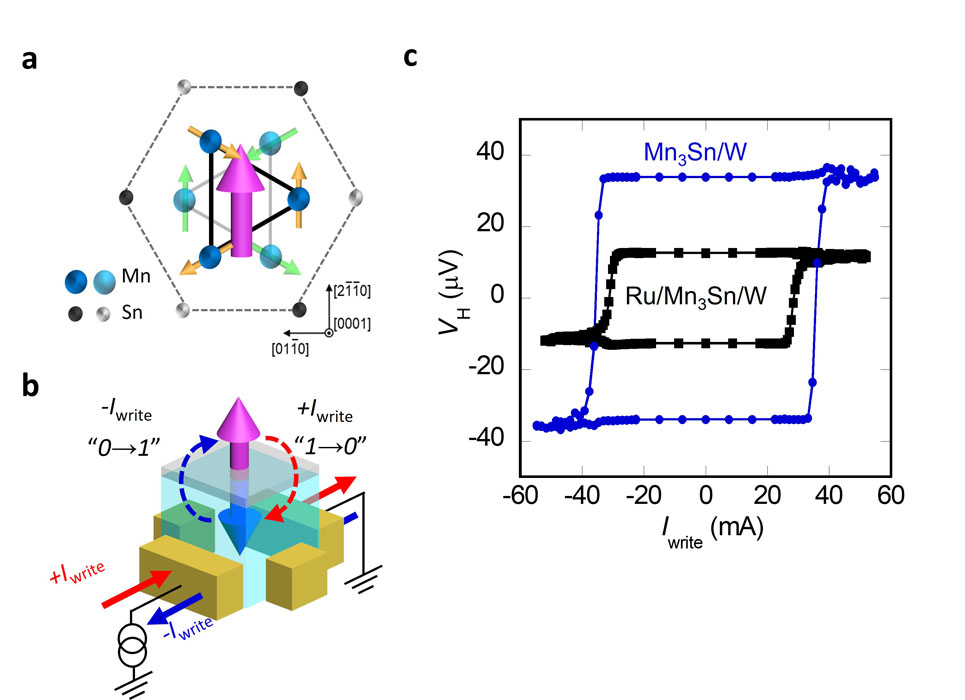Enhanced Anomalous Hall Signal by Electrical Manipulation in Antiferromagnetic Weyl Metal Mn3Sn
Nakatsuji, Otani, and Miwa Groups
Topological properties may play a significant role in developing next-generation electronic devices. Weyl semimetals characterized by linearly dispersive band touching points may exhibit surprisingly large topological transport responses, such as anomalous Hall effect (AHE), anomalous Nernst effect (ANE), and chiral anomaly. Manipulation of such topological responses electrically may lead to a new type of nonvolatile memory device.
Recently, electrical manipulation of topological responses for a magnetic Weyl semimetal has been demonstrated. Magnetic switching using spin-orbit torque (SOT) is established in the antiferromagnet Mn3Sn (Fig. 1(a)) [1]. Figure. 1b shows the schematic of the electrical switching in Mn3Sn/W memory devices. The polarization of the flowing current determines the orientation of the magnetization of Mn3Sn. The different states of Mn3Sn can be read by measuring the Hall voltage, namely “0” and “1” states. For application purposes, it is essential to develop means to enhance the readout signal of the magnetic switching in Mn3Sn. Several ingredients determine the signal's magnitude, such as geometrical factors of a memory cell, shunting current, and volume fraction of the switching domain. While the former two are extrinsic and tunable by changing the magnetic cell and layer structure, the latter is intrinsic to the cell that consists of a multilayer stack.

Fig. 1. (a) Crystal and spin structures of Mn3Sn. The non-collinear spin structure consisting of six Mn magnetic moments (yellow and green arrows) can be viewed as the ferroic ordering of a magnetic octupole (purple arrow). (b) The schematic of the electrical switching in Mn3Sn/W memory devices. Two different states of Mn3Sn, “0” and “1” states, can be determined by the polarity of applying current. (c) Enhancement of the switching Hall voltage in the Mn3Sn/W bilayer is three times larger than the value observed in the previous Ru/Mn3Sn/W multilayer.
This work optimizes the multilayer structure and deposition process and realizes a three-time enhancement of the readout signal (Hall resistance). The Ru buffer layer is removed from the reported Ru/Mn3Sn/W layer to decrease the current shunting effect, and the Mn3Sn/W bilayer is directly deposited on the Si/SiO2 substrate. Moreover, additional annealing progress at the Mn3Sn/W interface is applied to suppress the roughness at the Mn3Sn /W interface; as a result, the roughness is decreased to 0.5 nm, one order of magnitude smaller than that of the reported Ru/Mn3Sn/W thin film.
The obtained AHE signal of the Mn3Sn/W thin film is twice larger than the previous value reported for Ru/ Mn3Sn /W thin film. Based on the X-ray diffraction analysis, both the decreased current shunting effect and the different orientation of Mn3Sn domains contribute to the enhancement of the AHE signal. In the current switching measurement, the switching volume fraction calculated by the ratio between electrical and field switching signals is 50%, around 1.5 times larger than the reported value. The enhancement of the switching fraction is likely related to the higher spin injection efficiency at the interface due to the smooth interface. The enhancement of AHE and the switching fraction result in a three-time enhancement of the switching Hall resistance (Fig. 1(c)). This finding may bring memory devices based on topological antiferromagnet closer to real-world applications [2].
References
- [1] H. Tsai, T. Higo, K. Kondou, T. Nomoto, A. Sakai, A. Kobayashi, T. Nakano, K. Yakushiji, R. Arita, S. Miwa, Y. Otani, snd S. Nakatsuji, Nature 580, 608 (2020).
- [2] H. Tsai, T. Higo, K. Kondou, S. Sakamoto, A. Kobayashi, T. Matsuo, S. Miwa, Y. Otani, and S. Nakatsuji, Small Sci. 1, 2000025 (2021).
